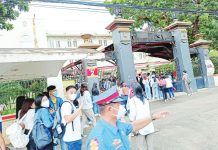
FIREWORKS have long been a symbol of celebration, their dazzling lights and booming sounds marking the peak of festive occasions. Yet, beyond the fleeting moments of joy they bring, fireworks leave behind a trail of economic and public health costs that many fail to acknowledge. In Western Visayas, where 11 fireworks-related injuries have already been recorded this holiday season, the broader implications warrant closer scrutiny.
Every injury caused by fireworks carries a heavy financial burden. Hospitalization for blast injuries, burns, or eye trauma often requires specialized care, from emergency procedures to extended rehabilitation. For victims in rural areas who rely on non-sentinel hospitals, access to adequate treatment can mean additional transportation costs and out-of-pocket expenses. These financial strains are particularly devastating for low-income families, who may already be struggling to make ends meet.
The economic toll extends beyond medical bills. Injuries sustained during the holiday season often lead to loss of productivity, as victims — many of whom are breadwinners or students — are forced to take time off work or school to recover. For employers, this translates to reduced workforce capacity during a critical time for businesses. In cases of severe injuries, such as amputations, the long-term impact on a victim’s ability to earn a livelihood can be profound, perpetuating cycles of poverty.
The public health implications are equally concerning. Fireworks-related injuries place an additional strain on already stretched healthcare systems, diverting resources that could be used for other pressing needs. During peak periods like New Year’s Eve, hospitals in Western Visayas must brace for an influx of cases, often requiring overtime from medical staff and prioritization of emergency care. This heightened demand can delay treatment for other patients, creating a ripple effect across the healthcare system.
Children are disproportionately affected by fireworks injuries, which often result from the misuse of banned items like the boga or unsupervised handling of pyrotechnics. Beyond physical harm, these incidents can have lasting psychological effects, including trauma and fear. The societal cost of these injuries is immeasurable, as they erode the sense of safety and joy that celebrations are meant to bring.
Fireworks may be ingrained in cultural traditions, but the price we pay for this practice is simply too high. Organized community fireworks displays offer a safer, more controlled alternative, ensuring that the spectacle can be enjoyed without the associated risks. Public awareness campaigns must emphasize not only the dangers of fireworks but also the financial and societal costs of injuries.
Policymakers and local government units must take a stronger stance by enforcing regulations and providing safer alternatives, such as light shows or sound-emitting devices. Encouraging innovation in celebratory technologies can preserve the festive spirit while eliminating harm. Also, businesses that manufacture and sell fireworks should be held accountable for promoting safer products and educating consumers on their proper use.
It is time to confront the true cost of fireworks and choose a path that prioritizes public health and economic stability. As Western Visayas prepares to welcome 2025, celebrations need not come at the expense of lives, livelihoods, and well-being.







